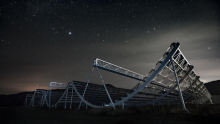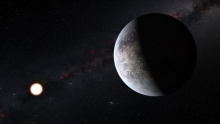Fleeting blasts of energy from space, known as fast radio bursts (FRBs), are a cosmic enigma. A Canadian-led international team of researchers has published new findings suggesting that supernovae are the predominant contributors to forming sources that eventually produce FRBs.


This week Canada announced it will contribute to the European Space Agency’s Ariel mission. A first mission of its kind, the Ariel space telescope will launch in 2029 to study the atmospheres of distant exoplanets outside of our solar system. Up to 12 Canadian astronomers, including McGill University experts, will be at the front row of the mission, with privileged access to its data. (Canadian Space Agency)

An array of 350 radio telescopes in the Karoo desert of South Africa is getting closer to detecting the “cosmic dawn” — the era after the Big Bang when stars first ignited and galaxies began to bloom.
A team of scientists from across North America, Europe, and South Africa has doubled the sensitivity of a radio telescope called the Hydrogen Epoch of Reionization Array (HERA). With this breakthrough, they hope to peer into the secrets of the early universe.

How do stars form in distant galaxies? Astronomers have long been trying to answer this question by detecting radio signals emitted by nearby galaxies. However, these signals become weaker the further away a galaxy is from Earth, making it difficult for current radio telescopes to pick up.

The McGill Space Institute (MSI) and the Institute for Research on Exoplanets (iREx) at Université de Montréal are at the forefront of the exhilarating pace of space research, helping to advance our knowledge of extrasolar planets, fast radio bursts, the dark universe, and other extraterrestrial mysteries. Now their stellar work and efforts to recruit top students and researchers are getting a huge boost thanks to extraordinary gifts to McGill University and the Université de Montréal from the Trottier Family Foundation.

Astronomers have unveiled the first image of the supermassive black hole at the centre of our own Milky Way galaxy. This result provides overwhelming evidence that the object is indeed a black hole and yields valuable clues about the workings of such giants, which are thought to reside at the centre of most galaxies. The image was produced by a global research team called the Event Horizon Telescope (EHT) Collaboration, using observations from a worldwide network of radio telescopes. Astronomers from McGill University were part of this global effort.

When did the Earth reach oxygen levels sufficient to support animal life? Researchers from McGill University have discovered that a rise in oxygen levels occurred in step with the evolution and expansion of complex, eukaryotic ecosystems. Their findings represent the strongest evidence to date that extremely low oxygen levels exerted an important limitation on evolution for billions of years.

XO-3b, a hot Jupiter on an eccentric orbit. Credit: NASA/JPL-Caltech/R. Hurt (IPAC)

Mini-Neptunes and super-Earths up to four times the size of our own are the most common exoplanets orbiting stars beyond our solar system. Until now, super-Earths were thought to be the rocky cores of mini-Neptunes whose gassy atmospheres were blown away. In a new study published in The Astrophysical Journal, astronomers from McGill University show that some of these exoplanets never had gaseous atmospheres to begin with, shedding new light on their mysterious origins.

Scientists at the University of Montreal and McGill University have pioneered and tested a new genomic methodology which reveals a complex bacterial ecosystem at work on the International Space Station.
Until now, relatively little was known about the different types of microbes found on the space station. The new approach enables researchers to identify and map different species inside the ISS, which will ultimately help safeguard astronauts’ health and be key to future long-term space travel.

Canadian researchers, including TISED Associate Director, Prof. Jeff Bergthorson (Department of Mechanical Engineering, Alternative Fuels Laboratory, McGill University), believe metals could fuel a new clean energy era. Professor Berghtorson's team is in Sweden tonight to launch a clean energy experiment into space!

$1 million donation from Trottier Family Foundation to fund McGill Space Institute fellowships
